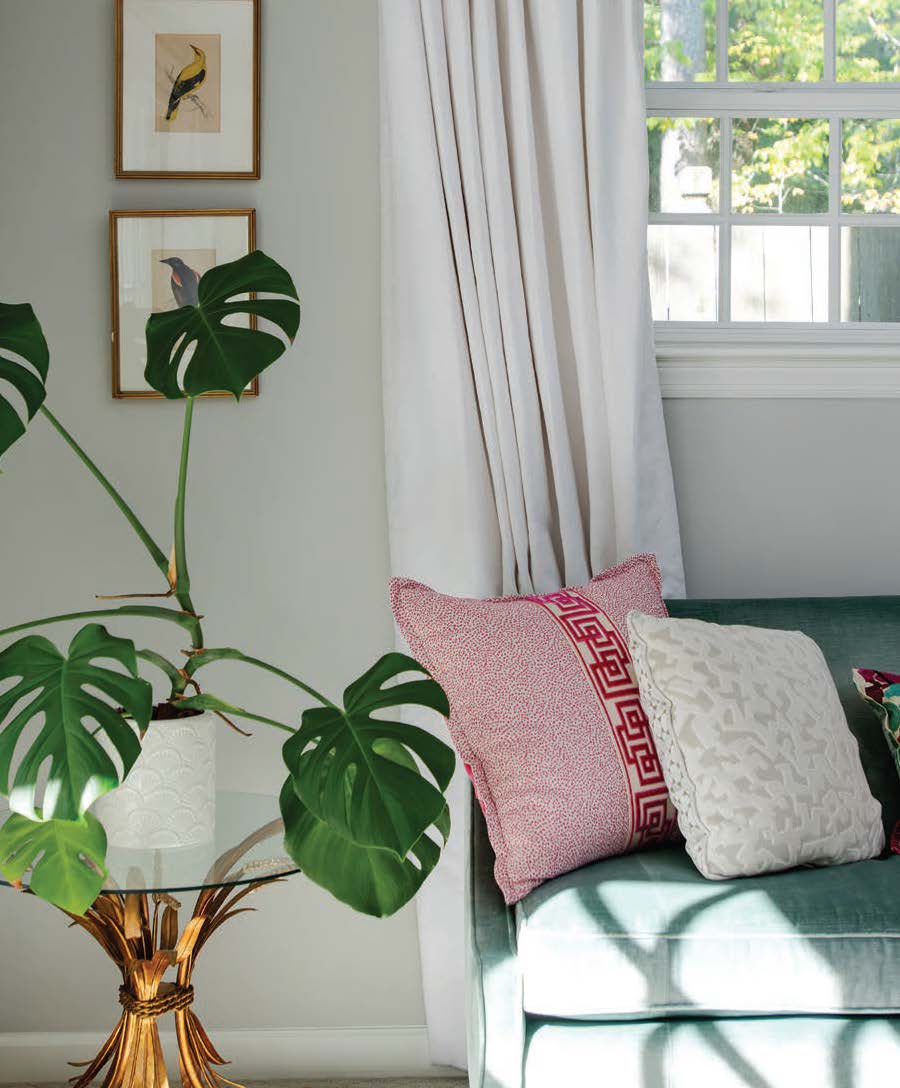From High Fashion to Home Furnishings
FROM HIGH FASHION TO HOME FURNISHINGS

From High Fashion to Home Furnishings
A passage to India leads to design inspiration
By Cynthia Adams
Photographs by Amy Freeman
Elizabeth Wicker’s home renovation is a living laboratory, where she tinkers with sophisticated, restrained design, luxe wallpapers and sparkling touches. And yet there is a disciplined approach, and no clutter.
In her dining room/home office, she recently created a credenza in her role as a Chelsea House designer. The piece, newly arrived, could be popped between the two new bookcases of her design, or be used elsewhere, she says. A small, blown-glass bull on the shelf was purchased at Modern 214 in High Point, however, redolent of her time in Spain, and is not her design. She holds it in her hand, thoughtfully weighing it.
An ethereal Douglas Freeman painting hangs between the two bookcases.
The dining table, doing double duty as her work table, is a glamorous Hollywood Regency style also found at Modern 214. “It’s the first place I go when I get to market.”

The wall color used throughout much of the upstairs is a pale Benjamin Moore gray, number 1611, a favorite, trimmed with Decorator’s White in high gloss — a serene backdrop to art and furnishings. If it reads too blue with different light, she tweaks the tint.
“This is my house. My passion project.”
The graphic wallpapers Wicker chose 10 years ago when she first moved in still work.
Cranes wallpaper by Cole & Son in the foyer is a favorite. Her older brother walked in as the house was being renovated and stopped. “Beeb” (her nickname), she recalls him saying, “this wallpaper reminds me of something from our house growing up.” She laughs and shrugs. (But privately, she’d wondered, had something in her past inspired the choice?)
Wicker’s home, however beautiful, is equally spotless.
She enthusiastically describes snuggling on the neutral living room sofa with her poodle-Cavalier King Charles mix, Sienna Rose. (The settees and sofas are all custom-sized to fit each niche and space, a benefit of working in the industry.) “Only if she has her blanket,” Wicker qualifies.
She sheepishly continues.
“I’m a little OCD about cleanliness.” Her friends tease her with a barrage of questions: “Do I have shoes for her to wear if it gets really muddy?” Yes. “Do I make her wear them all the time?” No. “But did I try when she was a puppy?” Yes.
“Sienna Rose has been the best thing for me.”
Wicker moves through her home, picking up objects to illustrate her design style. A line of mother-of-pearl boxes are personal favorites. Sales reps told her they were a little pricey, but she stood her ground.
“Well,” she told them, “Let’s see if you can do it!” The boxes wound up being a best seller, she says proudly. But that is not always the case. Home furnishings sales are mercurial, with variables such as bad weather, poor market attendance or poor buyer traffic at any given market. A white cachepot of her design has remained a best seller for Chelsea House. She has another one out, and two new trays are styled on kitchen counters, one using mother-of-pearl.
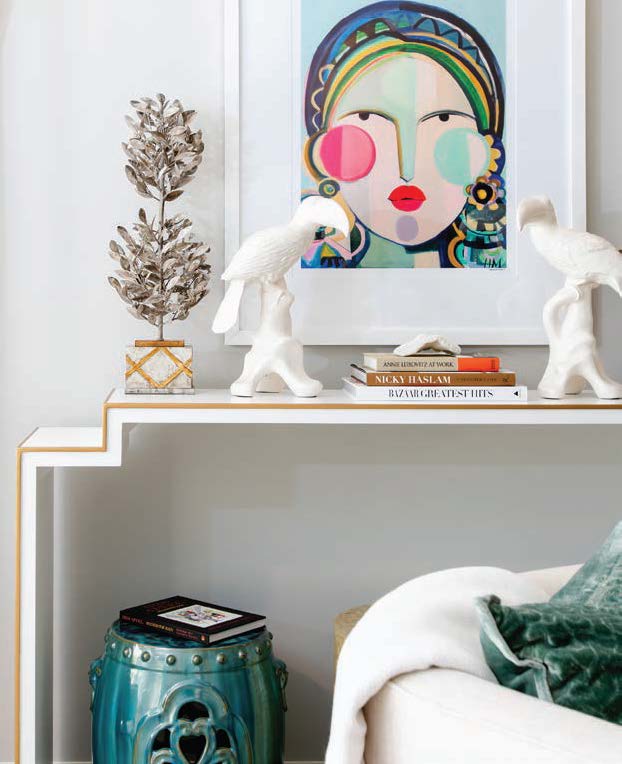
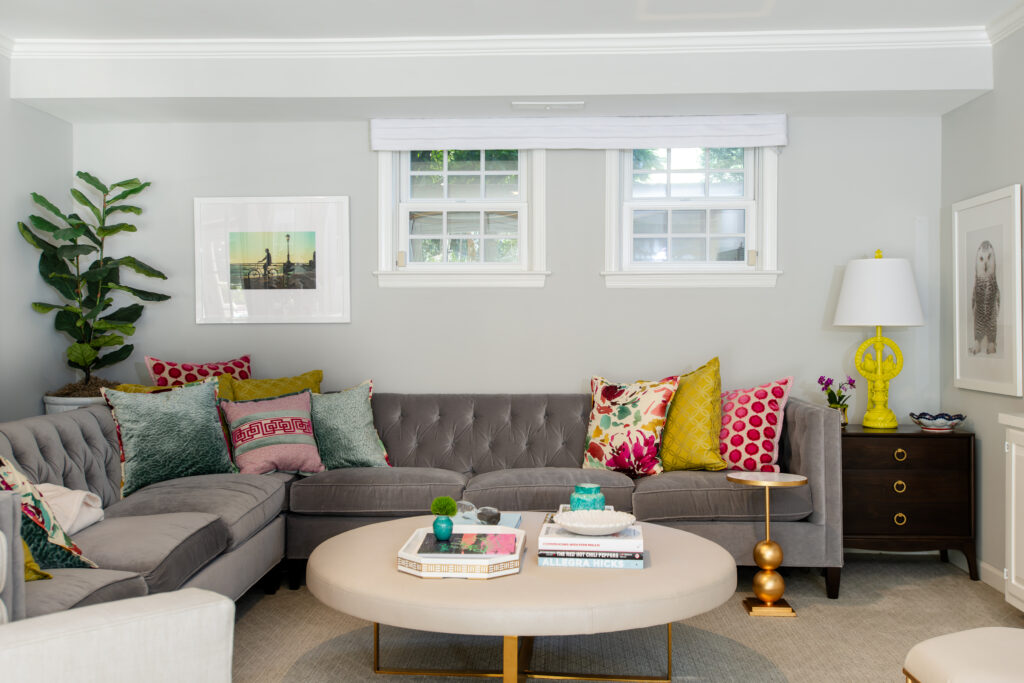
Among the 100 or so pieces she designs each year are personal favorites that don’t make it into production. If this disappoints her, Wicker doesn’t complain. Rarely, too, is she disappointed by a design’s execution in manufacturing.
Wicker pauses before a large Art Deco-style mirror template she taped to the wall behind her desk. She studies the physical pattern a moment while scrutinizing the computerized version on one of two work screens. Details consume her and must be exact.
“This is the reason I bought the house,” she says, leading downstairs, shot with abundant natural light and luxuriant space.
The basement level is a revelation. Equally restrained, it is also light, youthful and fun, designed for comfort and also further design experimentation. Wicker camouflaged an unfortunately placed fireplace with antique mirrors and reconfigured the large space, where she formerly worked.
She points out Chelsea House designs used in the decor here.
“Down here is a bestselling cocktail table, lacquered, originally detailed in gold leaf.” Wicker personally favors small cocktail tables with heft, which she says are useful when entertaining, substantial enough to not tip over.
A side table in crisp white with brass accent is a signature Wicker design.
The glamorous basement powder room featuring a graphic wallpaper and a “Material Girl”-era Madonna photograph is much appreciated by her close friend, lawyer Andrew Spainhour. He teases Wicker, saying, “Pardon me, I’m going to go visit Madonna.”
He has dubbed Wicker’s downstairs her “Genie room.”
“Like I dream of I Dream of Jennie, where she went to the bottom of her genie bottle?” Wicker explains. She’s piled cushy pillows around the sectional sofa.
A framed collection of vintage Vogue illustrations is a nod to Wicker’s fashion background.
The basement opens onto a covered outdoor entertaining area with a louvered privacy wall of her design that includes a hidden jib door. There’s ample space for Sienna Rose to run, she adds, nodding towards the large yard. Here, too, Wicker’s neatnik nature is on full display. Dog toys are neatly stacked as her pooch visits Wicker’s parents.
“I sit at the end of that step,” she shares, clearly besotted by her pet. “Sienna Rose gets to the fourth step and tends to look back to be sure I’m still there.”
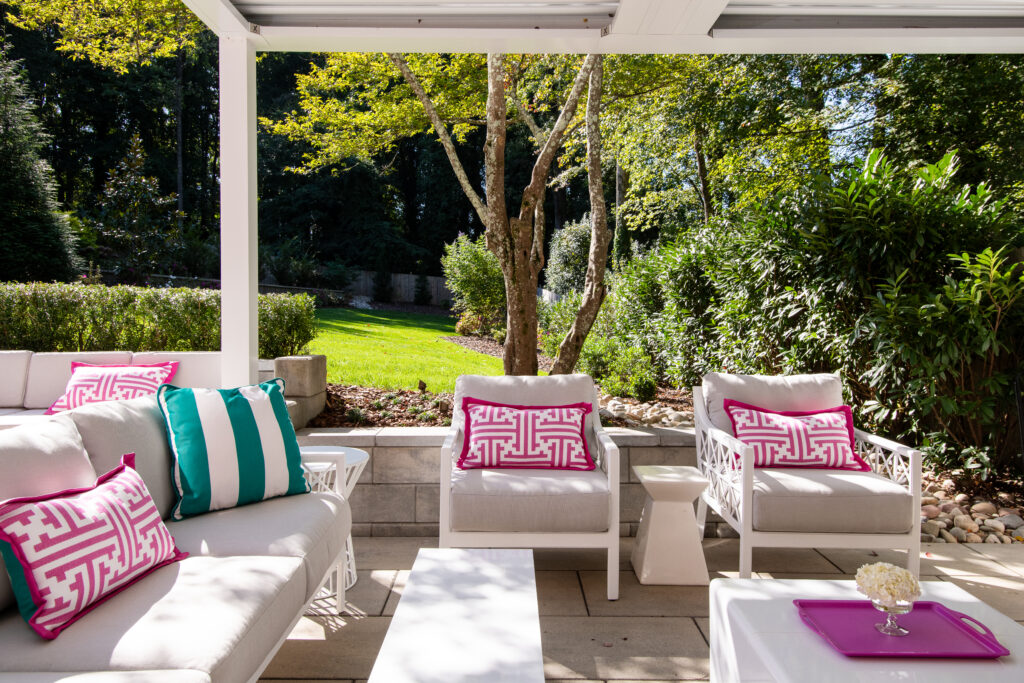
Upstairs, she describes having revamped bathrooms, then transforming spaces by hanging papers selectively for graphic punch. By claiming much of the primary bedroom’s closet, Wicker expanded a formerly cramped en suite bath.
Striking details, like the impressive brass pulls on custom bathroom cabinetry, reveal a little more genie-style magic.
“They’re actually tie-backs,” Wicker says.
An antique French settee in her bedroom fits her maxim: You “must mix the old with the new.” Wicker lacquered a vintage credenza to make it read more of the moment.
The artwork she acquired fits with elegant restraint. Nothing competes with anything else. She mentions two favorites — eye-catching, large canvases. One hangs directly in front of her work table.
Both are by Freeman, an admired artist and her friend.
“When he brought this over, he said he wanted this in the hallway.” Wicker was hesitant as workmen were still on site; she didn’t want it harmed. Freeman was insistent, hanging it where it remains today. It is all the more meaningful to her as he subsequently died.
She smiles wistfully; it is a grace note.
“It’s my little labor of love, and I love my home,” she repeats, then flashes an enormous smile.
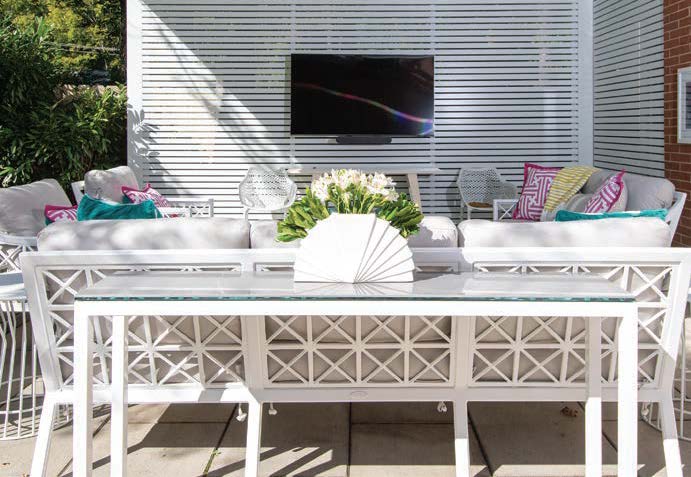
When Elizabeth Wicker was profiled as a Triad boomeranger — those ultimately returning home — it still surprised even her. She never expected a return to Greensboro after a career-making move to the Big Apple, where she worked for fashion maven Nanette Lepore.
Today, she sees a beautiful symmetry to her trajectory and believes here is exactly where she is meant to be.
“I’m a boomerang and I’m all down for it,” Wicker says. “Cecelia Thomspon [executive director of Action Greensboro] is one of my best friends here.” Thompson conceived the very idea of Boomerang Greensboro, which promotes those who formerly lived here returning.
Initially, a series of unfortunate events brought Wicker back in 2014.
A creative pivot from fashion to furnishings design was unexpectedly easy for Wicker.
Years perfecting dressmaker finishes and finer details for haute couture lent itself to the granular detail she now applies when designing for home furnishings giant Chelsea House. At 44, she is enjoying a challenging career working with home appointments versus high fashion.
Wicker is among 10 designers working independently for Chelsea House, which celebrates its 50th anniversary this year.
How her reset unfolded is one part fairy tale and ten parts hard work. Her design evolution also involved a revelatory business trip to India. When Wicker returned to Greensboro, those parts meshed in a transformative way.
She was always an independent, free spirit, remembers friend Sara Jane Gibson, who has known Wicker “since we were in diapers in the same play group. I tuned into this in high school.” She noticed her friend’s unique dress style and eye for design. Wicker’s bedroom was pasted with a collage of varied photographs from ceiling to floor—anything that she fancied. “She had stickers on the interior roof of her car.”
It presaged her home, which became a personal design laboratory.
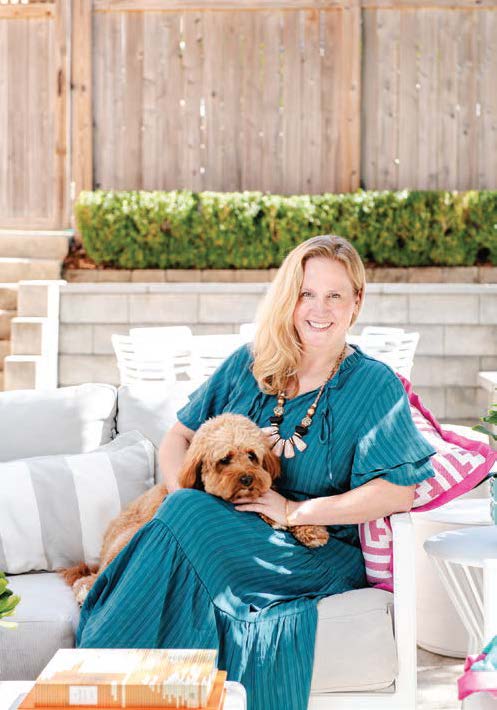
In her early years, Wicker was influenced by family travels. She observed how her grandmother “sewed everything,” and soon grew passionate about sewing and creating, even as a teenager.
Wicker pursued fashion design at N.C. State after graduating from Page High School and studied abroad in Spain. Still in college, she produced handbags and clutches under her own brand, Isabaya by Elizabeth Wicker. “I didn’t keep up with the trademark,” she says.
When the televised design competition Project Runway began its popular run, watching the pace stressed her out, she recalls. Then a student, she couldn’t believe the show’s contestants made designs so quickly.
Despite all that, Wicker confesses imagining she’d eventually study law and follow her father, Robert Wicker, in becoming an attorney.
Yet design opportunity opened. She won an internship with Lepore in New York, where she remained for six years. This led to Lepore employing Wicker as a liaison between design and production.
“Lepore was known for her details, embellishments,” Wicker says with admiration. “Intricate designs. Nothing was just basic.” The free-spirited designer matched Wicker’s own enthusiasms — “a little gypsy” spirit. “I loved working with her; it was so much fun, and living in New York was fantastic.”
But a series of setbacks for the design house hit. (The designer no longer owns the brand and has since shuttered her studio.) Then Wicker’s rent escalation forced her to give up her apartment in March 2008.
Yet she hadn’t contemplated returning to her hometown. “I’d had all these great experiences — it felt; ah, am I ready for that?” Then her parents ran into her former soccer coach, who works in the textiles industry. He relayed a message to Wicker: “Tell her to send me her resume.”
She relocated to Greensboro and joined underwear-and-hosiery manufacturer Kayser-Roth. After a year, she met and joined Triad designer Bradshaw Orrell, partner of the late Freeman, and began working with his clients and, ultimately, managing the business.
Orrell was already designing for Chelsea House. In the process of the firm working on their High Point showroom, Wicker had begun ghost-designing for Chelsea House, too, “which isn’t odd at all in the design world.”
Then, a misadventure changed her career once again.
Orrell asked Wicker to join him on a business junket visiting 26 India manufacturers for Chelsea House. She only knew they would be “seeing their capabilities and seeing products that were already in the works that we had designed.”
Arriving in New Delhi in January of 2020, Wicker quickly cleared customs. Orrell did not. She watched helplessly through a glass panel with mounting alarm as he was turned back by customs officials.
“They sent him back that night because his visa was not up to date . . . and I’m just his sidekick going on this trip!” Although she was familiar with the process of how furniture pieces are made, “I had never been in India, and didn’t know exactly what Chelsea House wanted and what we were to do.”
Wicker didn’t even know any contact names of those they were meeting.
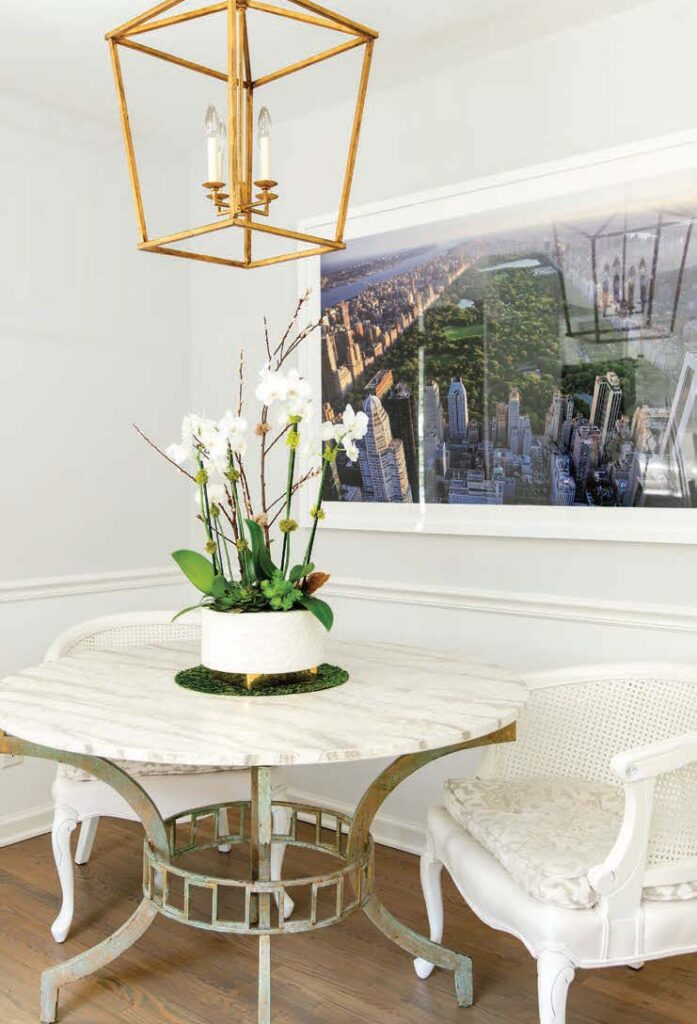
Their prearranged agent, Parik, met her at the airport with knowledge of the itinerary. She realized she had to go to four appointments the next day, unsure of what was expected, nor how to navigate expectations.
Gibson, who lives in Charlotte, called Wicker five times when she learned her friend was there alone.
“I just knew she was going with her boss . . . she’s savvy and could have navigated, but I was just worried about her.” Gibson adds, “She’s always had a big personality . . . She’s a leader and a woman on a mission.”
“It was mind blowing. Amazing. But I got so sick,” Wicker recalls. She had packed basics for stomach upsets and headaches that did little for her symptoms. Her whole body ached.
“My throat closed up. It wasn’t until about six months later that I realized it was COVID.”
Wicker isn’t an adventurous eater at best, and now she had no sense of taste nor smell. Parik diplomatically told everyone she only “ate dry food.” She munched on crackers and granola bars. And kept going. Wicker never smelled the rich curries and spices that are the stars of Indian cuisine.
After that first day in India, she thought, “I can do this!” She had moved from “I have to do this” to “I can do it!” At night, she would collapse in bed, sweating and ill. She lost her voice and could barely communicate. But she soldiered on.
Factory managers would ask Wicker whether she liked things they presented, carefully waiting for her to speak. “I wasn’t supposed to be the main person, but they wanted to show me what they could do. Everyone was so respectful.” She could absorb the sensory richness — textiles and architecture — of India if not the foods and aromas. “The colors! I loved it all!”
With Parik’s help, Wicker completed the entire 12-day agenda on her own.
“I loved it,” she repeats. And her creativity ignited.
She had feverishly “designed about 75 pieces while in India in collaboration with the people at the factories.”
She flew back on a Sunday, her health improving. By Tuesday morning she was back at work, sending out new designs.
Wicker was exhausted. Elated. And changed.
She also turned 40 that summer, celebrating with a group of friends who have long been in her life. Wicker walks over to a bookshelf and picks up a magnifying glass she designed for friends as a party favor. It echoed her love of some of the nostalgic family items she values.
After returning from India, Chelsea House’s executives called Wicker to express support. By November, their new president contacted her about creating another line of furniture — in two weeks. She managed while still working full-time with Orrell. She continued both until 2022.
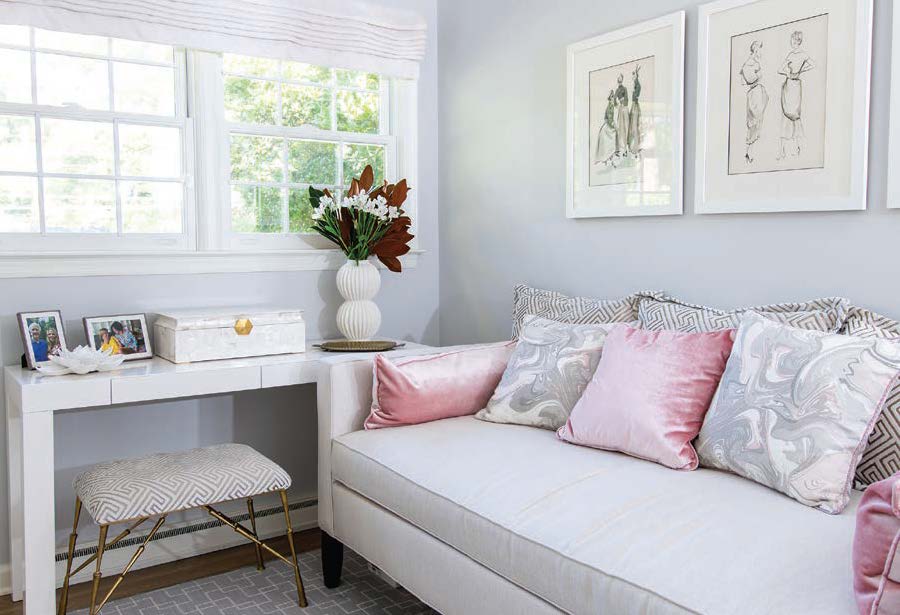
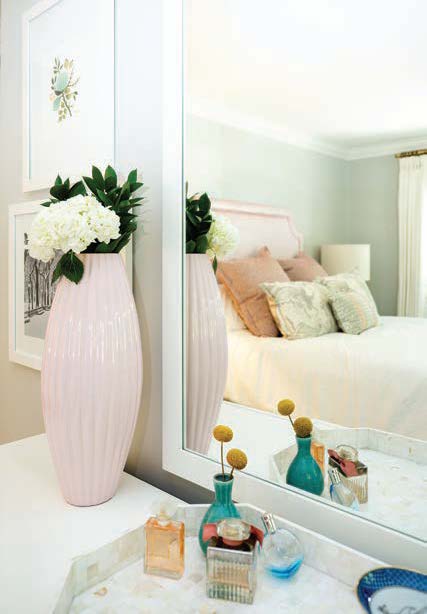
“I learned so much there,” she says of her 12 instructive years with Orrell.
But India had changed “my thinking and career . . . It was the turning point.”
Her designs are also plucked from personal references and life experiences. An alabaster apple she designed from one of the reeded-front bookshelves literally reflects her time in New York, the real Big Apple.
This includes both furniture and “the jewelry” — her term for the accessories she designs, such as trays and cachepots.
“I put pressure on myself to give as many details as possible.”
What is the narrative thread in Elizabeth Wicker’s design life?
“Outside influences,” she answers. She went out into the world, like a design explorer, and brought it all back to her studio. New York City, Spain and then India became touchstone places.
Her Instagram page describes her as “chasing everything creative.”
“It’s a matter of letting yourself go. You may not be great at something — but you find your way. Your mind, your heart, everything will tell you where to go. It will lead you, for sure. That happened to me.”
Random, even mundane things, can mean an epiphany.
“I found packaging — this piece of cardboard! The way it was cut out and folded, I opened it and thought, hmmm. This would be a great body of the lamp. A base!”
Or, while eating out West on vacation: “There was the coolest design on the end of the fork. Something I’d never seen before.” Her fellow diners were amazed she noticed.
“It’s definitely not one-two-three” she says. The design process is different every time. But she firmly believes in routines.
Up at 7, she religiously makes her bed and jumps in the shower. “I do things for myself. Alone time. Get up and moving, and Sienna Rose sometimes goes to doggie daycare or stays here with me.” Wicker is, failing calamity, working by 9:30.
“You’ve got to get in a routine, and I learned that long before COVID.”
There are long hours, too, she admits, “when you ask ‘What did I even get done?’”
Two weeks earlier, Wicker was on a getaway with girlfriends in Darien, Connecticut. While browsing the shops, she spotted one of her designs and had a moment. “This has never happened to me,” she insists. “The girls started saying, in high-pitched voices, ‘Oh my gosh!’”
The store owner asked Wicker’s name. “I turned beet red.” They requested a photograph of her with the piece. “It was a really cool experience. Then I looked over and spotted another of my pieces.” Her heart lifted.
What feeds her? Her parents were “guiding light people,” she praises. They gave her tools of self-reliance.
“They gave me the freedom to explore my creative side and to travel. No limitations set on me in the sense, I never remember their saying stop doing that.”
So she hasn’t.
Rituals for enhancing creativity? Noticing things. It may not inspire a new product idea. But perhaps the texture of a leaf, or the undulation of packing material, the mundane, pricks the subconscious inspiring a new finish.
Sometimes just walking along a path does the trick.
“Get a dog,” she winks.

